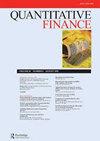三角洲的微笑
IF 1.4
4区 经济学
Q3 BUSINESS, FINANCE
引用次数: 0
摘要
【摘要】Fukasawa引入了隐含波动率smile的归一化变换。数学。金融,2012,22(4),753-762]在给定的隐含波动率smile上不存在蝴蝶套利的两个必要条件,要求Black-Scholes公式的函数d1和d2必须递减。在本文中,我们利用delta中的smile参数化来表征满足这些条件的smile集合。我们通过一个实数和三个正函数得到了这种微笑集合的参数化,从业者可以使用它来校准弱无套利微笑。我们还证明了这样的微笑和它们的对称微笑可以通过双射转换成走向空间中的微笑。我们的结果激发了利用delta参数化来表征蝴蝶无套利微笑子集这一具有挑战性的问题的研究。关键词:隐含波动率波动率微笑edeltabutterfly套利el分类:G13C60C63致谢我衷心感谢Zeliade Systems,特别是Claude Martini给我与他们合作的机会,并每天拓宽我的知识。由于客户ccp需要在西格玛空间中进行波动率校准,从而可以在走向空间中进行转换,因此本文的结果得以实现。我感谢Stefano De Marco对这篇文章的准确阅读,以及提出的改进建议。我要感谢Antoine Jacquier,他指出了关键的改进,Vladimir Lucic热情地分享了他的基础知识。披露声明作者未报告潜在的利益冲突。本文章由计算机程序翻译,如有差异,请以英文原文为准。
Smiles in delta
AbstractFukasawa introduced in Fukasawa [The normalizing transformation of the implied volatility smile. Math. Finance, 2012, 22(4), 753–762] two necessary conditions for no butterfly arbitrage on a given implied volatility smile which require that the functions d1 and d2 of the Black–Scholes formula have to be decreasing. In this article, we characterize the set of smiles satisfying these conditions, using the parametrization of the smile in delta. We obtain a parametrization of the set of such smiles via one real number and three positive functions, which can be used by practitioners to calibrate a weak arbitrage-free smile. We also show that such smiles and their symmetric smiles can be transformed into smiles in the strike space by a bijection. Our result motivates the study of the challenging question of characterizing the subset of butterfly arbitrage-free smiles using the parametrization in delta.Keywords: Implied volatilityVolatility smileDeltaButterfly arbitrageJEL Classification: G13C60C63 AcknowledgmentsI sincerely thank Zeliade Systems and especially Claude Martini for giving the opportunity to work with them and daily broaden my knowledge. The results in this paper have been achieved thanks to the concrete need of client CCPs of a volatility calibration in the sigma space which can be converted in the strike space. I thank Stefano De Marco for the precise reading of the article, and for the improvements suggested. I thank Antoine Jacquier who pointed out crucial refinements, and Vladimir Lucic who shared his fundamental knowledge with enthusiasm.Disclosure statementNo potential conflict of interest was reported by the author(s).
求助全文
通过发布文献求助,成功后即可免费获取论文全文。
去求助
来源期刊

Quantitative Finance
社会科学-数学跨学科应用
CiteScore
3.20
自引率
7.70%
发文量
102
审稿时长
4-8 weeks
期刊介绍:
The frontiers of finance are shifting rapidly, driven in part by the increasing use of quantitative methods in the field. Quantitative Finance welcomes original research articles that reflect the dynamism of this area. The journal provides an interdisciplinary forum for presenting both theoretical and empirical approaches and offers rapid publication of original new work with high standards of quality. The readership is broad, embracing researchers and practitioners across a range of specialisms and within a variety of organizations. All articles should aim to be of interest to this broad readership.
 求助内容:
求助内容: 应助结果提醒方式:
应助结果提醒方式:


